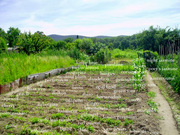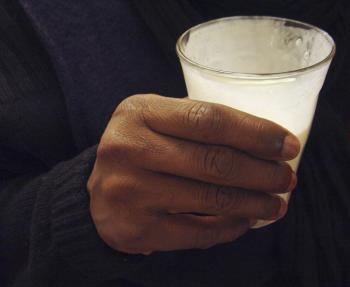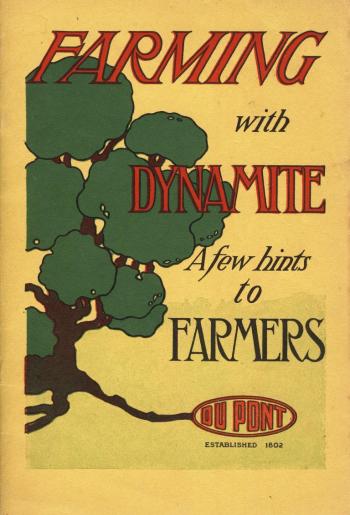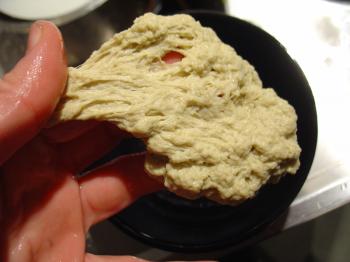Glutinous Maximus,
Grow yer own dang protein!
June 2, 2007
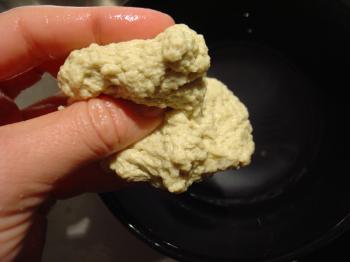
It may be beige, but it sure is some good eatin’…
There are days when in one go, we can be inspired enough to shrug off one hella lotta ballast of preconceived notion. Last night was one of those days, when in an ad hoc workshop at the cooking studio of Marlein and Inez, Tomoko taught us to extract wheat gluten from flour and how to make seitan.
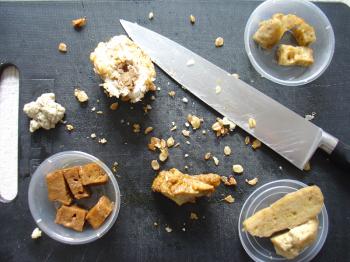
Seitan’s realm, clockwise from 9 o’clock: gluten loogie, steamed & marinated seitan in a bun, knife, steamed & fried but not marinated, simply steamed, steamed & fried, steamed & marinated & fried (my favourite).
Preconceived notion #1: Without even investigating, I had always assumed seitan to be a highly processed food, akin to textured soy or textured vegetable protein, a prominent member of the subset, ‘food designed by mono-maniacal dictators trying to score a big one in the name of food sovereignty’.
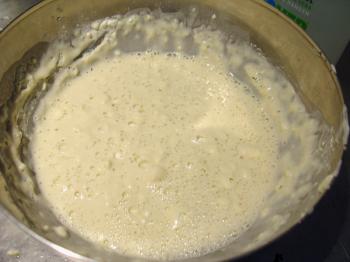
Flour power. As if wasting some precious wheat germ increases a carbon footprint, we used white flour for this daring experiment. Next time we’re goin’ brown.
Notion #1 debunked: Wheat gluten is a whole food, it already exists inside the wheat. You could argue that flour is processed wheat, but I would just argue back that you should just relax. The name seitan is a macrobiotic neologism invented by its founder in the 1960’s. Seitan refers to wheat gluten that has, by hook or by crook, been turned into something more satisfying than just another texture to put in your mouth and chew. To my knowledge (which is to say, to Google and Wikipedia’s knowledge) unlike many other proteinous foodstuffs, seitan has never been appropriated by a dictator to tow the party line. Soy, a well-known collaborator, cannot say the same.
To extract the gluten from flour, mix some flour and water into a sloppy, wet dough. Let it sit an hour or two in a slightly warm place.
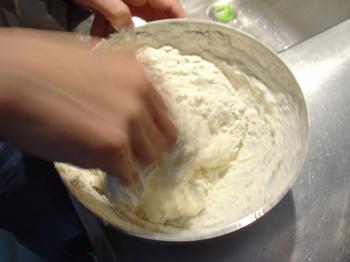
I knead you to knead me, I’m begging you to beg me.
After an hour or two, knead the wet dough for about 4 minutes and let it sit again for an hour. No need to be precise. Don’t be a follower, be a leader. I may be lying to you and I can’t follow an instruction to save my own life. It’s all about activating the gluten. (You know when you wash a bowl that has been filled with dough and all that clumpy doughy yucky stuff gets stuck in the metal wooly sponge-thingy and stays there for days making you not want to touch it? That’s gluten. You weren’t precise about it then, don’t be precise about it now.)
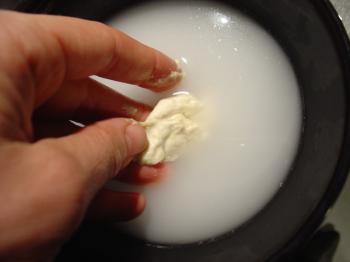
It’s sexy, it’s gross, massaging out all that starch
Preconceived notion #2: I thought that seitan was developed purely as a tummy-filling device by famine giddy monks suffering from high-altitude crop failure. And I thought seitan was a ‘faked you out’ sort of meat-substitute, and except for the starch, void of any nutritional value.
Notion #2 debunked: That’s just crazy talk. Turns out the technique for making wheat meat is indeed thousands of years old and was indeed invented by monks that may or may not smell of rancid yak butter, but seitan is in no way devoid of nutritional value. In fact, gram for gram, wheat gluten contains more protein than red meat and is only 1 percentage point shy of cheese! Pass the cheese please, and by cheese, you know I’m talkin’ ’bout Seitan.
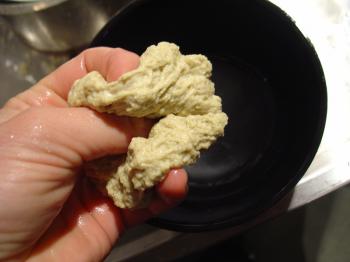
After the starch has been massaged out and rinsed away, 25% of the mass is revealed to be gluten
Preconceived notion #3: Without even bothering to try it, I thought that seitan was disgusting, void of flavour, rubbery in texture, akin to spent chewing gum.
Notion #3 debunked: This notion isn’t entirely untrue. In its lonesome, cooked wheat gluten is about as appealing as a plain boiled potato or boiled white rice. But like these foods, its popularity isn’t based upon how it behaves in its plain form. Nothing wrong with a bit of enhancement. Hell, I don’t unleash my ‘whole, natural self’ upon the world. I wouldn’t think of leaving the house without a big splash of perfume, some heels, a bra, and some profile flattering clothing. (And by profile, I mean tochas.) Same goes for wheat gluten, it wants to be infused with aroma and gussied up, marinated in a bath of kombu (seaweed), ginger, nama shoyu with a mushroom or two thrown in for good measure.
Zillions of pasta shapes have been designed into popularity according to how they absorb and ‘carry’ sauces. Like pasta, wheat gluten is a facilitator, ever willing to absorb accompanying flavours. If you prepare the wheat gluten by yourself, you can exert a lot of control over its texture. More on this in a subsequent entry, I’m still learning.
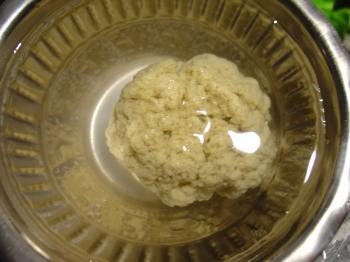
It looks like a matza ball, but it isn’t. It’s better. Let me be the first to assert that wheat gluten is better than a matza ball.
Store the extracted wheat gluten for up to 3 days in the fridge in some water while you learn how to transform it into the opposite of what it is right now. Buddhist much?
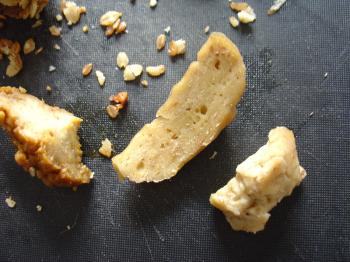
Closeup of steamed and fried seitan
That’s 3 myths debunked. Here are some links, now go make yer own dang protein…
- Bunshiro Fu - famous makers of pretty fu. Fu’s another word for wheat gluten.
- Futomi Yokoyama - manufacturers of fu, the other wheat gluten
- Hippy children in California exploring gluten
- Can you trust it? Wheat Gluten and Seitan on Wikipedia
- More iffy sources… Wheat gluten as food?
- Which leads us to Buddhist Cuisine… don’t go overboard
- A vegan body-builder and his vegan body-building diet explained at Vegetarian Teen (Seitanic praises for this magnificent website!)
- In Dutch unfortch:
Comparison of protein (1st %) and fat (2nd %) per 100 gram in common proteinous foods:cheese 25,5% 29%
seitan 24% 0%
lean beef 22% 20%
fish 17,7% 12%
flour 11,7% 02%
tempeh 17% 07%
tofu 11,2% 06,6%
debra at 13:12 | Comments (6) | post to del.icio.us

